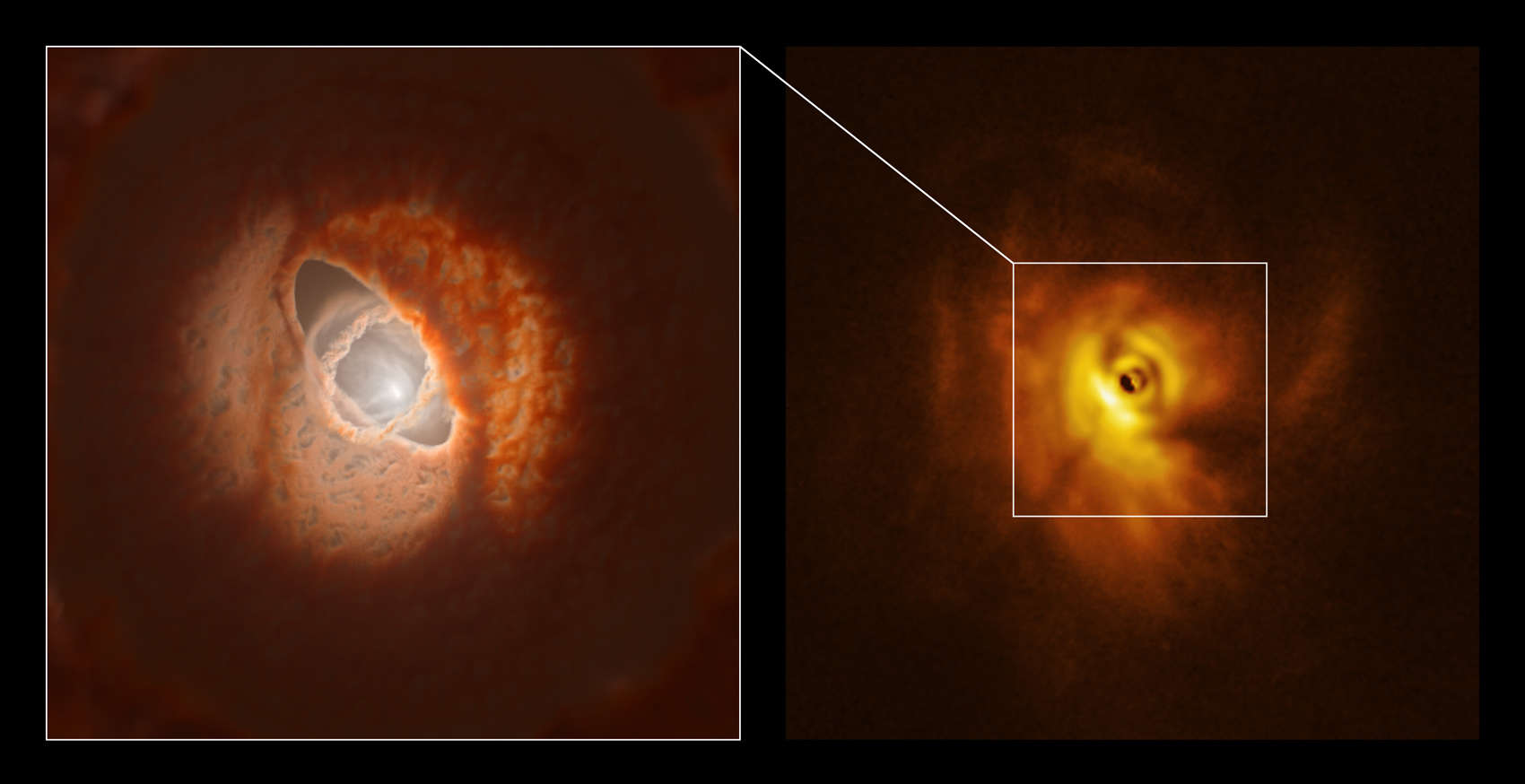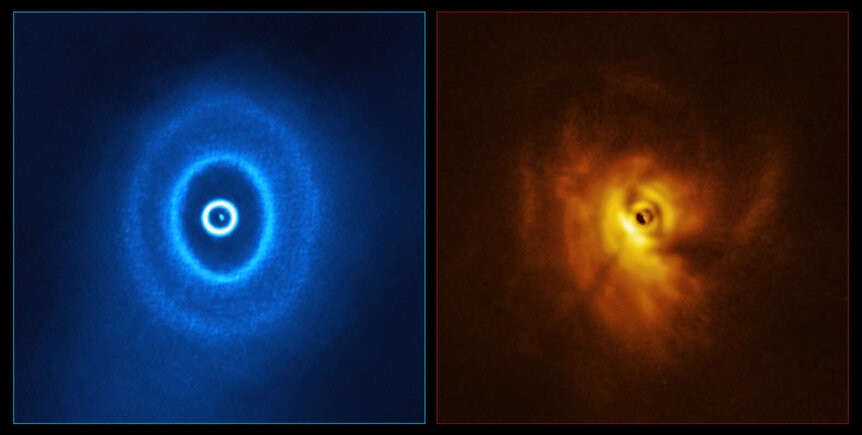Create a free profile to get unlimited access to exclusive videos, sweepstakes, and more!
Take THAT Tatooine: A planet may be orbiting a *triple* star system

In a possible exoplanetary first, astronomers have presented evidence of a planet orbiting around all three stars in a trinary star system. If true the planet would likely be massive, and revealed itself via its gravity torqueing a huge disk of gas and dust surrounding the stars, and carving a deep gap in it as well.
The star system is called GW Orionis (or just GW Ori), about 1,300 light years from Earth. It’s what’s called a hierarchical trinary, meaning it has two stars orbiting each other in a binary system with a third orbiting both farther out (like Alpha and Proxima Centauri). The two stars in the binary are separated by about 180 million kilometers (a bit farther than the Earth to the Sun) and the third orbits them at least 1.2 billion kilometers away (roughly the distance of Saturn from the Sun).
All three stars are surrounded by a vast disk of dust that extends out to 60 billion km and a gas disk that goes three times farther out. This means the system is young and still forming — once stars really get going they tend to blow away their surrounding material — and astronomers estimate their age as around a million years. The Sun is 4,600 times older, so this truly is a young system.
Things get weird when you look more closely. For one thing, the third star in the system (call GW Ori C) doesn’t orbit in the same plane as the two stars in the binary (A and B). But it’s the disk around them that’s truly bizarre. I wrote about this in detail when ALMA observations revealed the twisted structures in the disk. Literally.
The disk, which around most forming stars is usually quite flat, has been warped and even broken. High-resolution observations show parts of it have been sculpted into a series of rings. The innermost ring is about 7 billion km from the stars, the next is 27 billion, and the third, outermost ring is 50 billion km out. The middle and outermost rings are tipped to our line of sight, so they look like ellipses (in the same way the rim of a glass seems elliptical when seen from an angle). Both the outer rings are coplanar, sharing the same flat plane, but it’s tipped with respect to the binary orbit.
The inner ring is tipped both with respect to the binary and to the two outer rings. And it gets worse: In between the inner and middle ring is a big gap. There’s some material in there, and it forms two deep “hoods”, concave structures pointing in opposite directions.
If you’re having trouble picturing this, even with the diagrams, join the club. It’s a very, very strange system — the NRAO website has a lovely interactive diagram of the system where you can pan and zoom and tilt around; give it a try to get a better grip on what this all looks like.
What could possibly form all these peculiar features? The obvious candidate to an astronomers is that third star with the tilted orbit around the binary. It could be yanking on the material outside, torqueing it, breaking the disk into rings and causing it to warp. Early simulations were conflicted about that, though; some showed it wouldn’t work while others showed it could.
In the new research, astronomers looked again to see if they could solve this. They first used orbital simulators to model how the stars orbited each other, and then used particle simulators to model the behavior of the disk as the stars moved.
What they found is that they couldn’t get the third star to break up the disk or cause the rings to act in the way seen. There were certainly some affects, but nothing drastic enough to explain what’s observed.
So in their simulations they added a planet. Planets form out of the material in disks around stars so this isn’t an ad hoc assumption — it makes sense a planet could be there. They gave it the same mass as Jupiter and placed it 15 billion km out from the binary, in the middle of the big gap (about three times farther out than Neptune from the sun), and orbiting in the same plane as the binary. They found that the misalignment of the material outside the stars torques the planet, giving it a tilted orbit in short order.
The planet then, under certain conditions, starts to affect the ring. They found that if the disk is thick (10 times wider than it is thick) then they can’t get the planet to break it into rings. But if it’s thin (20 times wider than thick) the planet can break it up. It can also carve a gap in the disk that is similar to the gap seen between the inner and middle disks.
I’ll note they don’t model the two odd hoods of material, and that will probably take quite a bit of further simulation to make work. But they do get the overall tilts and behaviors of the rings that match well with observations, and also show that the three stars alone can’t do that.
This points very provocatively at the presence of a massive planet in the system.
There have been planets found orbiting in trinary star systems before, but these orbit one or two of the stars, not all three (Proxima Centauri has at least two planets orbiting it and one of the stars of Alpha may have one as well, for example). If this work pans out, then it will be the first true circumtrinary planet found.
Very roughly half of all stars are in binary systems, with perhaps 1/5th in trinary or higher systems. The mechanics of a planet orbiting in such a collection of stars is… complicated, and it’s not clear how they would form. If observations can confirm a planet orbiting the stars of GW Ori it would be a big step in determining how this all might work.
We struggle to figure out how our relatively simple single-star-and-eight-planet solar system works, such are the interactions in it both subtle and gross. But there could be much, much weirder things out there. We’ve already seen some, and many more await both our discovery and our understanding.
















